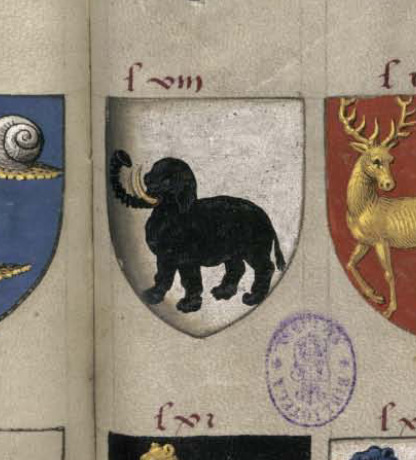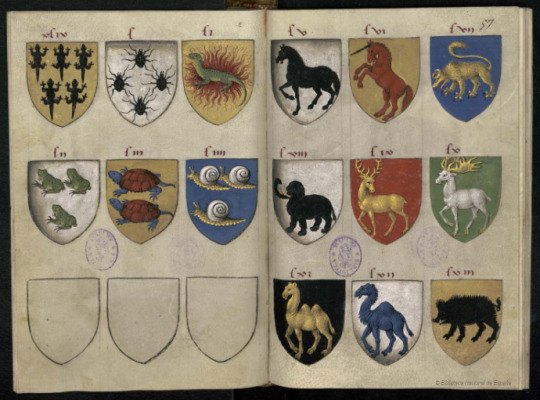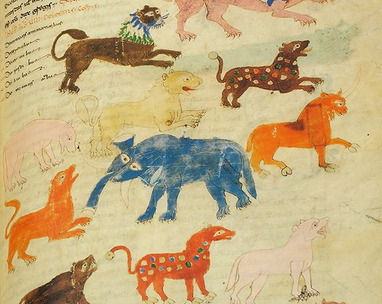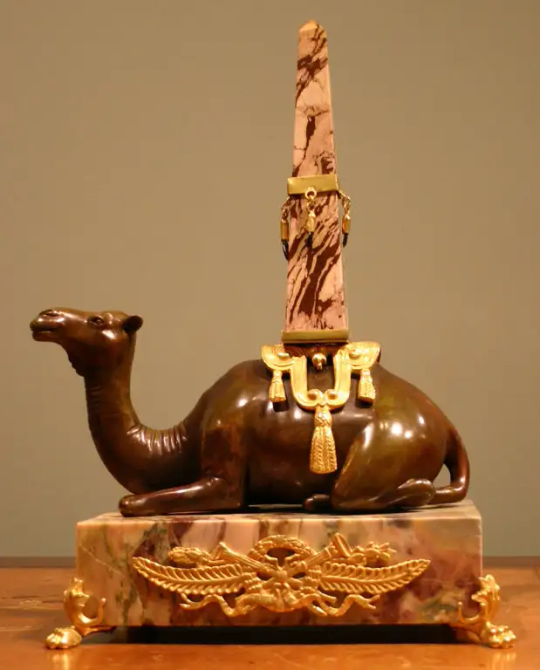Searching for evidence of elephants in the global Middle Ages
Don't wanna be here? Send us removal request.
Text

Hats off to the long-eared elephant that forms the crest in the arms of the marquis of Las Navas. This images appears at the start of the manuscript to assert the Las Navas family's ownership of this manuscipt of Guido delle Colonne's History of the City/Destruction of Troy (Historia Civitatis Troiane) that was made in Italy (Venice?) in the 14th century.
Crests were used in tournaments to identify different jousters, perhaps a bit like the way people choose avatars in a game like Mario Kart. German tournament books show people admiring a range of helmets with some fairly elaborate crests before a tournament.

Image above from Das Wappenbuch Conrads von Grünenberg (now Munich, BSB Cgm 145, f. 233r. (This manuscript also includes more examples of elephants in heraldry, but that's a story for another time!)
Some crests depicted in manuscript illuminations were pure fantasy, however, and were never actually made into helmets in reality.
Material: parchment and pigments Place of creation: Venice (with later additions?) Date: between 1325 and 1401? Now Biblioteca Nacional de España MS 17805, f. 2r
#elephant#elephants#medieval elephants#illuminated manuscript#medieval#manuscript#14th century#italian art#heraldry#spanish history
53 notes
·
View notes
Text

Head in the clouds...
This 15th- or 16th-century depiction of an elephant was made in Vietnam. The blue and white designs on china, however, may have been inspired by art from Ming Dynasty China. The Met's catalog description notes that 'The salty taste of the surface of the dish suggests it was recovered from a shipwreck.' I wonder how the curator found out that the dish tastes salty? Medium: Cermanics Date: 15th or 16th century Origin: Vietnam Now Met Museum, Asian Art 1998.213
#elephant#elephants#medieval elephants#medieval ceramics#ceramics#stoneware#vietnam#vietnamese art#asian art
57 notes
·
View notes
Text

Let's be a medieval manuscript with mama
5K notes
·
View notes
Text
In the 2023 film Tetris, one character remarks that 'great ideas have no borders.' (I've been trying to find a real-life version of this quotation from the creators of the Tetris company, but this may be a rare case when Hollywood improved on real life.) At any rate, this sentiment seems to have been as true for medieval legends as for modern video games, judging from two fourteenth-century manuscripts.
These manuscripts were written in the same century contain the same stories about elephants and depict similar scenes: however, they were made 5,000 miles apart and were written in different languages. One was made for the king of France, the other may have been made in Mamluk Baghdad.

Image above: miniature with a king and an elephant from Raymond de Béziers translation of Kalila wa Dimna (now Paris, BnF, Latin 8504, f. 78v)
The text they contain is a series of animal fables about two jackals (or wolves, in European translations) who serve the lion king. These stories were probably originally told in Sanskrit in India, before being translated into Persian and then Arabic. The Arabic version is known as Kalila wa Dimna.
The stories continued to be told for centuries, and in the early 1300s, a physician called Raymond de Béziers translated the text into French at the behest of Queen Joan/Jeanne for her husband, King Philip IV ('the Fair') of France. (You can learn more about this text and manuscript in Nancy Freeman Regalado, 'Kalila et Dimna, Liber Regius', in Satura: Essays on Medieval Satire and Religion in Honor Of Robrt Raymo, eds. Nancy Reale and Ruth Sternglanz. Donington: Shaun Tyas, 2001, 103-23.) It is unclear if Raymond knew Arabic or if he was working from Spanish version of the text.

Philip IV and his children depicted at the beginning of Raymond's translation of Kalila wa Dimna. His daughter, Isabella, is depicted with the three lions of England because she was the queen of King Edward II of England (BnF Latin 8504, f. 1v).
It should be noted that medieval translators adapted as much as translated these works and gave themselves much more room for creativity than modern translators would take. Still, the stories-- and even the aspects that the illuminator chose to depict-- would have been recognizable many thousands of miles away in Baghdad, where these stories were still being told.
A few decades after Raymond made his book for the king of France, in 1354 a manuscript was made in Baghdad of the same tales, also featuring elephant imagery.

Image above: image with an elephant from a mid-14th century copy of Kalilah wa Dimna, now Oxford, Bodleian Library, Pococke 400, f. 148a.
And a few decades after that, around 1389, the story of a king and a white elephant from Kalilah wa Dimna was depicted in yet another deluxe copy of the stories made in Baghdad.

Image above: elephant herder with a white elephant and king from Cambridge, Corpus Christi, MS 578, f. 106r
So same century, same story, but many different artistic styles and rather different audiences!
PS See this great blog from the Parker Library in Cambridge for more elephant lore!
#elephant#elephants#medieval elephants#illuminated manuscript#manuscript#manuscripts#medieval#14th century#capetians#islamic art#french art
50 notes
·
View notes
Text

Early medieval artists in Northern Europe do not seem to have understood the concept of an elephant's trunk. However, by the late 12th century, perhaps due to extended trade links, northern artists were adding trunks and other key features to their depiction of elephants. Nevertheless, this particular artist was still a bit shy about the size of an elephant's trunk and ears. Content: Medical treatises Origin: Liège (in modern-day Belgium) Date: c. 1175 Now BL, Harley 1585, fol. 67v H/t Discarding Images
#elephant#elephants#medieval elephants#manuscript#illuminated manuscript#12th century#medieval manuscript#medieval art#medieval
28 notes
·
View notes
Text

And now for something completely different... The image above seems to relate to a passage not about elephants, but about camels. The manuscript above says these animals are "olfenda", or camels (in the second visible line), and the illustrator has drawn something that looks like camels. In other manuscripts of this text, however, the creatures who live in the land are described as ylpenda, elephants and illustrated in various imaginative ways. (This text is a copy of the Wonders of the East, an Old English text describing myths about Asia and Africa.) Incidentally, in all these manuscripts, the next section of text (adjacent to the image) claims to refer to a group of people (cende men), but it seems to interpolate some elements of elephant lore there, too. These people are reportedly 15 feet tall and have long noses and dark hair (as well as two faces and red knees). You can see "lange nosa" in the middle of the last line. (And yes, elephants can have dark hair.) These people get on a ship to India to give birth, echoing claims by Isidore that elephants existed primarily in India and stories about elephants travelling east to give birth in water, such as those found in ancient texts like the Physiologus (a 2nd-century collection of morality tales drawn from animal behaviors).

In Communal Creativity in the Making of the 'Beowulf' Manuscript, Simon Thomson has convincingly argued that the error in the text (olfenda) came first, and then one of the manuscript's artists followed the text and drew camels. So was it just a simple misreading by a scribe's tired eyes? Or did someone alter the text because olfenda were more believable than elephants?
I'm bringing it up here because research for my article has caused me to wonder: who had access to knowledge about elephants in the British Isles and other regions where elephants were scarce or non-existent?
Many of the surviving manuscripts, writings, and artworks that feature elephants from the pre-Norman Conquest period would have been available only to a small intellectual elite: literacy was extremely limited and books-- made from animal skins-- were extremely expensive. (If you think of the average manuscript costing the price of 500 leather jackets-- before you added any expensive pigments or gold or wrote anything on the page-- you get the idea.) At the very least, you would have had to travel in-person to specific library to have a chance to see these manuscripts, and then you'd have needed the connections and knowledge of reading and possibly other languages to understand what you were seeing. Even the elephant riddle written by Bishop Aldhelm would have had a limited audience: Bishop Aldhelm's Latin was notoriously difficult and learned. (There were stories about elephants that widely circulated in the sermons of Abbot Ælfric of Eynsham, but that is a story for another day...)
So were the scribes who wrote and illustrated the Beowulf manuscript outside the highest intellectual elite? Or did they just not have access to elephant information? Of course, people with access to the same information, even working in the same place, could draw the same animal in slightly different ways. Thomson argues that the Beowulf manuscript had more than one artist: you can see this difference in the drawings of earless, slightly dinosaur-looking camels fighting ants just a few pages earlier (f. 101v).

Materials: Parchment, ink, pigments Origin: England (but beyond that, highly debated) Date: c. 975-1030 (again, highly debated) Now British Library, Cotton MS Vitellius, f. 103v
#elephant#elephants#medieval elephants#manuscript#camel#camels#Beowulf#Old English#medieval literature
7 notes
·
View notes
Text

Trunk show This tenth-century silk fragment-- sometimes called the 'Elephant Tamer' silk-- was excavated in Iran in 1925. Scholars have debated whether it was made in the Byzantine Empire or the area that is now Iran. Or perhaps it was a Persian textile inspired by Byzantine textiles which in turn were inspired by earlier, Sassanian textiles from Persia, as C.J. Hilsdale has suggested... Silk was relatively easy transport and was traded and exchanged widely (hence the term, Silk Road). In particular, textiles might have been a way that images of elephants traveled all the way to places like Japan, where elephants did not live.
Incidentally, some have suggested you can see the tips of elephants' wings at the bottom of the slik. Material: silk Origin: probably Persia (or the Byzantine Empire?) Date: 10th century Now Dumbarton Oaks, BZ.1927.1
#elephant#elephants#medieval elephants#textiles#silk#art history#byzantine empire#persian art#10th century
26 notes
·
View notes
Text

Angry elephants? In your dreams... According to a book of dream interpretation made about 1000 years ago in Canterbury or Winchester, if you dream about an antagonistic elephant (or ylp in Old English), that might indicate something about an accusation. Handling ivory (ylpes ban in Old English) in a dream signifies a big obstacle. Dreaming about buying or selling ivory means great sadness. Eunuchs and iron are also bad news, but if you dream of handling wheat your trade will increase. (You can find an edition and transation of the full text-- known as the Somniale Danielis after the Biblical prophet Daniel-- in Roy Liuzza, Anglo-Saxon Prognostics: An Edition and Translation of Texts from London, British Library, MS Cotton Tiberius A.iii (D.S. Brewer, 2011), p. 95.) This particular manuscript is a fascinating"handbook" probably made for an archbishop of Canterbury with everything an archbishop might need-- from the rules his cathedral staff lived by to spare sermons to notes on pregnancy-- and apparently dream interpretation was also a going concern for a busy archbishop. (For more on this manuscript, see Tracey-Anne Cooper, Monk-Bishops and the English Benedictine Reform Movement: Reading London, BL, Cotton Tiberius A. iii in Its Manuscript Context (2015).)
As you can see, the text above was written in Latin and someone at Winchester or Canterbury translated it into English in the smaller, more spaced out lines in between the Latin lines. The Latin version circulated relatively widely in Europe and was itself based on earlier Greek dreambooks. Some Greek dreambooksgives more options for the meaning of dream elephants. According to one Byzantine dreambook, dreaming about seeing elephants or being chased by them means you will be overpowered by your enemies; however, dreaming about sitting or riding on an elephant signifies great honors. Oberhelmann has suggested that the chasing elephants may have been inspired by war elephants. (See Steven M. Oberhelman, Dreambooks in Byzantium (2016) for a translation of the full text of this dreambook.) Meanwhile, the tamed, ridable elephant also echoes classical motifs about the noble, wise, even virtuous elephant. It just goes to show that while humans have been dreaming about elephants for thousands of years, we never quite dream the same way.
#elephant#elephants#medieval elephants#manuscript#dream#dream interpretation#dream meanings#dreams#medieval#11th century#archbishop of Canterbury#Latin#Greek#Old English#Byzantine
30 notes
·
View notes
Text

Elephants and the invention of chess
As noted earlier on this blog, early chess sets feature elephants, viziers, and chariots, and features of Asian warfare, rather than the bishops and kings and queens of today.
Where did his all begin? One story can be found in an epic history of Persia (greater Iran) from the beginning of time. According to this epic-- said to have been composed by a figure called Ferdowsi around 1000 AD-- the game of chess was invented in India to soothe a grieving mother after one of her sons died fighting the other on the back of elephants. The board was arranged to explain the battle, with chariots, elephants, and other features of early Asian and Indian warfare represented.
It has long been argued that the term "check mate" in English (or échec et mat in French, etc) comes from the Persian phrase "shah mat" (meaning "the king can't escape" or the "the king is perplexed" or defeated). According to Ferdowsi, the victorious warrior did not kill his brother, although his brother did die on top of his war elephant when he realized that there was no escape. This is the subject of the page above, from a deluxe copy of Ferdowsi's work made around 1330 AD.
Materials: ink, pigments, gold, silver, paper Origin: Iran (Isfahan?) Date: c. 1330-40 Now Met Museum 1974.290.40
#elephant#elephants#medieval elephants#illuminated manuscript#14th century#persian#epic#chess#history of chess
25 notes
·
View notes
Text

Stars, stripes, and elephants This guide to different heraldic symbols was associated with Frederick of Aragon, King of Naples. Tentatively dated to 1501- 1504, it's just outside the usual scope of this blog, but who can resist a collection that includes shields decorated with eyeballs, gloves, cherries, flowers, birds, dogs, and various geometric shapes.

On the opening with the elephant alone, there are frogs, lizards, spiders, a unicorn, stags, turtles, snails, camels, even a wild boar: an interesting mixture of animals which were common in western Europe (stags, snails), which were associated with warmer climes, and which were mythological (unicorn). (The salamander was all of the above: although it's a real animal, it was the subject of many legends, such as as the suggestion that it was so cold it could live in fire, as depicted on the third shield on the left-hand page.) You can read more about this manuscript in A Heraldic Dream: the Treatise on Blazon of Frederick of Aragon, last King of Naples by Catherine Yvard, or you can view the whole thing online.
Material: Parchment, ink, and paints Date: 1501-1504 Now la Biblioteca Nacional de España, Ms 1467, f. 57r
#elephant#elephants#medieval elephants#illuminated manuscript#16th century#unicorn#medieval unicorn#naples#early modern naples#aragon#heraldry#coats of arms
43 notes
·
View notes
Text

Taking the elephant by the ears...
This soapstone carving (called a nomoli) shows a giant man riding the back of a petite elephant who is trampling his enemies. It was probably made by an artist from the Sapi people who inhabited the area that is now Sierra Leone in fifteenth and sixteenth century.
Sapi artists' work with (bits of) real medieval elephants was also highly prized: their elaborately carved ivory salt cellars, trumpets, spoons and more were traded with other African leaders and with Portguese merchants in the fifteenth and sixteenth century. Soapstone carvings such as the above have been used to prove that Sapi carvings were part of a wider tradition, and not just prompted by European trade. It is a testament to Sapi artists' skill that they could adapt to so many different styles, to find markets for their work. See Isaac Samuel's article for more discussion. Material: soapstone Origin: West Africa (area that is now Sierra Leone) Date: Before the sixteenth century Now Atlanta, High Museum of Art, 2014.392
11 notes
·
View notes
Text

Feeling blue? 1000 years before the blue elephant emoji was added to phones, some Italian monks drew this elephant and friends in a manuscript for Abbot Theobald of Monte Cassino. Monte Cassino was an important monastery and home to St Benedict whose rule is the basis for the Benedictine Order of monks and nuns that still exists today.
This manuscript contains an abbreviation of Hrabanus Maurus's De Rerum Naturis (On the Natures of Things). Hrabanus Maurus (d. 856) was archbishop of Mainz. In addition to encyclodpedia-like works sucha as De Rerum Naturis, he wrote Biblical commentaries, grammars, teaching texts and poems with complex palindromes. He wrote so much that his surviving writings fill about 6 modern type-set volumes.
Materials: parchment, pigments, ink Contents: Hrabanus Maurus, De Rerum Naturis Date: 1022-1032 Now Archivio dell'Abbazia, Montecassino, MS 132 (image from a facsimile)
88 notes
·
View notes
Text

Say it with flowers!
This image of an elephant and castle comes from a 12th-century copy of the Roman writer Orosius's History Against the Pagans. It illustrates a passage on King Pyrrhus and his battle elephants. If you look closely, a soldier has popped out the side of the castle to direct the war elephant with some fragrant blooms.
Materials: parchment, ink and pigments Date: mid-12th century Origin: an Augustinian priory in Kirkham, Yorkshire Now British Library, Burney MS 216, f. 33r
#elephant#elephants#medieval elephants#war elephant#elephant and castle#yorkshire#orosius#medieval art#illuminated manuscripts#12th century
23 notes
·
View notes
Text
The Elephant and the Obelisk
From the Hypnerotomachia Poliphili_1499_Aldus Manutius_Venice

From "Le Songe de Poliphile"_1546_Jacques Kerver_Paris

Bernini's "Elephant and Obelisk"

Salvador Dali's Elephants

...

..

...

..

..

..

...Camel and Obelisk

..

...

..

...Rhinocerous and Obelisk

..

...

...

19 notes
·
View notes
Text

Cozy conflict
Two elephants fight in a copy of Ibn Bakhtishu (d. 1058)'s Manafi al-Hayawan (On the Uses of Animals), made c. 1297-1300 in the area that is now Iran. But while the elephants are fighting, the images and text reveals how humans shared knowledge and ideas across long distances.
The text mentions that elephants live 300 years and are afraid of rats/mice. These and other ideas about elephants that also showed up in European texts at least since Pliny. The Morgan catalogue also notes that the text claims that elephant dung (with or without honey) can be taken as a contraceptive: don't try this at home!
Meanwhile, some scholars argue that the images resemble Gok Medrese reliefs in Turkey, and both may have been inspired by art from China brought by the Mongols, who swept across Eurasia in the thirteenth century. This single page is a very interesting example of how ideas about elephants can reveal wider influences and links between humans.
Materials: Paper, ink, and paint Origin: Maragha Date: 1297-1300 Now Morgan Library, M 500, f. 13r
52 notes
·
View notes
Text

Feeling incensed?

This incense burner was made in Japan in the middle of the thirteenth century. Is just me, or is this grinning guy a tiny bit reminiscent of the way elephants were being depicted in the kingdom of England at around the same time? Materials: wood, crystals, metal, pigments Date: c. 1250? Origin: Japan Now Los Angeles County Museum of Art, M.2008.106a-b
#elephant#elephants#medieval elephants#incense#incense burner#13th century#japan#japanese art#medieval japan
46 notes
·
View notes
Note
Does 1563 count as Medieval? The Italian needlework design book Trionfo Di Virtu. Libro Novo by Matteo Pagano, published in 1563, has an elephant on p. 24r. The Metropolitan Museum of Art has a copy, accession Number: 37.47.1(46).
Thank you so, so much! What a fabulous line-up of critters!

8 notes
·
View notes